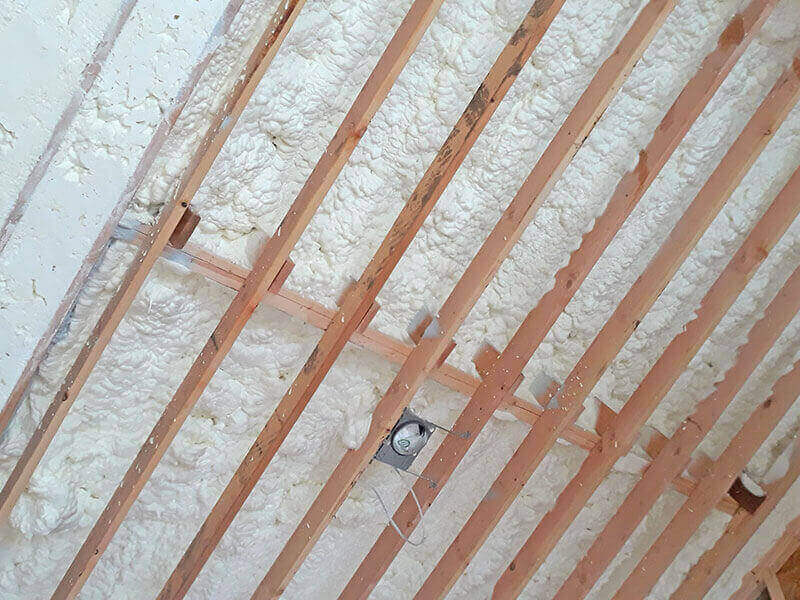The Appeal and Challenge of Vaulted Ceilings
Walking into a room with a vaulted or cathedral ceiling can be awe-inspiring. They can instantly elevate the look and feel of any home, creating a sense of grandeur and spaciousness, especially in custom homes in Missouri. However, for those with a vaulted ceiling, ensuring these beautiful architectural features are properly insulated can be a challenge.
In your home, heat naturally rises, making ayour open ceiling space a highway for heat loss in winter and heat buildup in summer. Traditional insulation like fiberglass batts often falls short, leaving you with high energy bills and potential moisture problems.

But there’s good news! There is a type of insulation that excels at insulating vaulted ceilings (drumroll please): spray foam insulation. By utilizing the unique properties of spray foam, you and other homeowners can enjoy the beauty of your vaulted ceilings while maximizing energy efficiency and comfort.
Why Vaulted Ceilings Need Special Attention
Vaulted ceilings are beautiful but tricky to insulate. Unlike flat ceilings with attic space, there’s little room for thick insulation layers between the underside of the roof and the interior ceiling. Plus, the structure’s complex angles, make it difficult for materials like fiberglass batt insulation or rigid foam board to provide complete coverage without gaps.
Most homes in Missouri and the Kansas City area, in places like Olathe, KS, Overland Park, KS, and Independence, MO, need ceiling insulation rated at a minimum R-value (insulating power) of R-49 to R-60 to handle our cold winters. But a typical 2×12 rafter cavity can’t reach that level with regular insulation, leaving many ceilings under-insulated by design.
It doesn’t stop there. Warm air inside your home carries moisture. As it rises into the ceiling, it can condense on the chilly roof, possibly leading to mold, mildew, and even the decaying of your wood or drywall over time. Our hot, humid summers and freezing winters only make things worse, trapping moist air inside the ceiling cavity if there’s no proper ventilation or moisture barrier in place. The best way to ensure proper insulation is with professional expertise.
The Problem with Fiberglass Batts in Cathedral Ceilings
Why not use fiberglass to get the job done? Fiberglass is one of the most widely used types of insulation and for years, fiberglass batt insulation was the go-to solution for vaulted ceilings. They are affordable and easy to find. But they only offer an R-value of about R-3.2 per inch. That means a fully packed 2×12 rafter can only hit about R-38, well below the R-49 to R-60 needed. Add in ventilation channels, and you’re looking at even less insulation, possibly as low as R-30.
Plus, fiberglass batts are air-permeable, which means warm, humid air can easily pass through, condensing on your chilly roof’s surface during winter. To prevent the passage of airflow and moisture, a separate vapor barrier is required, but even a small tear or gap can undermine its effectiveness.
There’s also the issue of installation. Cutting and fitting fiberglass batts into the steep, irregular angles of cathedral ceilings is difficult. Small gaps or compression are common, creating uninsulated areas. Over time, the batts can sag or shift, creating even more uninsulated areas. If it gets wet, it loses insulating power and can encourage mold to grow. Plus, handling fiberglass requires protective gear to avoid skin, eye, and lung irritation from the tiny glass fibers.
The Spray Foam Solution for Vaulted Ceilings
In more recent years, many homeowners and builders are choosing spray foam insulation as the solution to the unique challenges of insulating their vaulted ceilings.
Unlike traditional insulation, spray foam starts as a liquid and expands to fill cavities and seal every crack and crevice. It creates continuous, gap-free coverage that’s hard to achieve with pre-cut batt insulation. It also offers high insulation and air-sealing power in one step.
There are two main varieties of spray foam: open-cell and closed-cell, both with distinct advantages. Closed-cell spray foam is ideal for unvented vaulted ceilings, also known as a “hot roof” design. It provides an effective vapor barrier, sealing out moisture and preventing condensation on the underside of the roof.
This helps lessen the risk of mold, mildew, and structural damage. It also has a much higher R-value (about R-5 to R-7 per inch) than fiberglass, so that even in limited space, it can reach R-40 and higher to meet recommended energy codes.
Open-cell spray foam is lighter and slightly spongy when cured and has an R-value around R-3.5 to R-4 per inch. It’s great for vented vaulted ceilings with soffit vents and ridge vents and is vapor permeable to allow for breathability with proper ventilation. Open-cell foam fills complex cavities easily, blocks drafts, and is highly effective for soundproofing. This makes it ideal for homes near busy streets or noisy neighborhoods. As a homeowner, whether in Kansas City, Lee’s Summit or Independence, you may also choose to go for a hybrid approach, using both types for optimal performance. It’s very important to apply closed-cell foam first for moisture protection, then fill the remaining cavity with open-cell foam for added ceiling insulation R-value and soundproofing. This combo can hit R-values in the 40s and higher along with robust moisture protection, while keeping costs lower compared to installing all closed-cell foam.
Benefits for Missouri Homeowners and Builders
Spray foam insulation offers many benefits for Kansas City area homeowners and builders, everywhere from Johnson County, Kansas to Jackson County, Missouri. With our hot, humid summers and cold, blustery winters, maximizing energy efficiency is a top priority. Here’s how spray foam benefits Missouri and Kansas homeowners with vaulted ceilings:
Lower Energy Bills
Spray foam dramatically reduces your heating and cooling costs. It cuts down on your furnace and AC use, keeping your utility bills in check with proper insulation and air sealing.

Better Comfort
No more hot upstairs and freezing downstairs. You’ll enjoy steady, even temperatures throughout your home, while air sealing also eliminates drafts and cold spots.
Moisture Control and Healthier Living
The moisture control closed-cell spray foam provides means less risk of mold, mildew, and rot issues in your vaulted ceiling. You’ll protect both your family’s health and your home’s structure. Plus, the dense insulation helps keep out pests and dust, while open-cell foam dampens outside noise.
Building Code Compliance
Spray foam makes it easier to meet local codes and building energy standards without sacrificing your ceiling design. You’ll get high R-values without needing extra-deep rafters and your home will maintain its architectural design integrity.
Higher Home Value
Today’s buyers look for energy-efficient, low-maintenance homes. A well-insulated home, especially one with a vaulted ceiling can boost resale value, giving your home a competitive edge in the Missouri real estate market.
Reaching New Heights with Quality Insulation
Your vaulted ceiling doesn’t have to be an energy drain. The right insulation strategy, especially spray foam, lets you enjoy the beauty of your high ceilings while keeping your home efficient, comfortable, and healthy.
If you’re ready to tackle the insulation challenges of your vaulted ceilings, count on Kansas City’s number one insulation company, The Hayes Company to get the job done right. Our expert team provides top-notch insulation services and products to Kansas City area homeowners, contractors, and builders. As experts in spray foam insulation, we’ll help you achieve the ultimate in energy efficiency, comfort, and long-term home protection. Contact us today to learn more about our vaulted ceiling insulation solutions for your Kansas City area home.
References
Green Building Advisor. (n.d.). Insulation question regarding unvented vaulted ceiling. Green Building Advisor. https://www.greenbuildingadvisor.com/question/insulation-question-regarding-unvented-vaulted-ceiling#:~:text=If%20you%20want%20to%20create,impermeable
Missouri Extension. (n.d.). Energy management guide: Insulation (Publication No. EM0115). University of Missouri Extension. https://extension.missouri.edu/sites/default/files/legacy_media/wysiwyg/Extensiondata/Pub/pdf/energymgmt/em0115.pdf#:~:text=Flat%2C%20vaulted%20or%20cathedral%20ceilings,They%2C%20too%2C%20usually%20require%20the
Missouri Extension. (n.d.). Insulation materials and applications (Publication No. GH4881). University of Missouri Extension. https://extension.missouri.edu/publications/gh4881#:~:text=Fiberglass%20blanket%20or%20batt%202,3
Oak Ridge National Laboratory. (n.d.). Attic floor insulation fact sheet. U.S. Department of Energy. https://web.ornl.gov/sci/buildings/docs/factSheets/attic%20floors.pdf#:~:text=insulation%20and%20ventilation,Air%20sealgasket%20Scuttle%20hole%20cover


